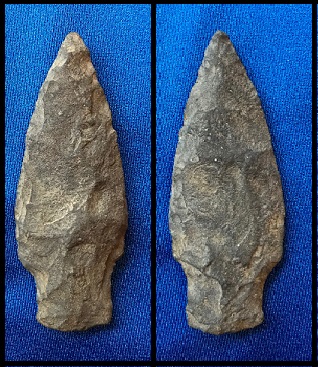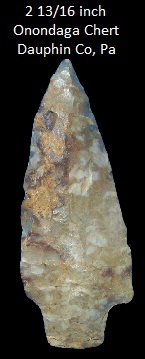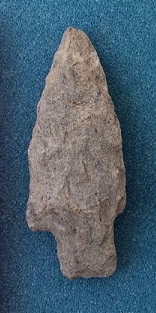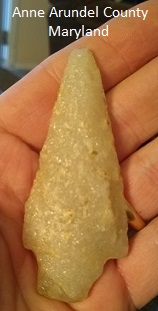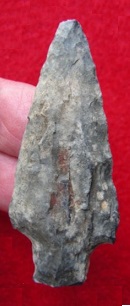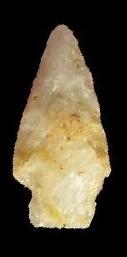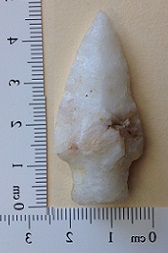Outline is Representative of Size and Shape:
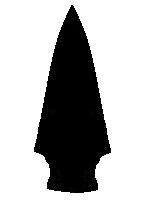
Name Details:
Identified By: Fred W. Kinsey
Named For: Type Site Location
Date Identified: 1959
Type Site: Kent-Hally site Bare Island, Pennsylvania
Identified By: Fred W. Kinsey
Named For: Type Site Location
Date Identified: 1959
Type Site: Kent-Hally site Bare Island, Pennsylvania
Point Validity:
Valid type
Kinsey was a distinguished Anthropologist who did extensive work in the Susquehanna River valley and eastern anthropology. This point was named in a professional publication and has many professional references. This is a valid type.
Kinsey was a distinguished Anthropologist who did extensive work in the Susquehanna River valley and eastern anthropology. This point was named in a professional publication and has many professional references. This is a valid type.
Bare Island Stemmed
Cluster: Lamoka Cluster Description of Physical Characteristics and Flaking Pattern:
This is a medium to large stemmed point with an elliptical cross section. The blade is primarily excurvate, but may have a straight blade on smaller examples. The shoulders are most commonly angled upwards, but some examples may have horizontal shoulders. The stem is straight with parallel sides. The base is primarily straight, but may be slightly convex. This point has a random flaking pattern.
Size Measurements:
Total Length - 30 to 97 mm (mean 51 mm), Stem Length - 11 to 18 mm, Blade Width - 10 to 30 mm (mean 21 mm), Stem Width - 14 to 19 mm, Thickness - 6 to 15 mm (mean 8.2 mm) (Richie, 1971, Kraft, 1975)
Total Length - 30 to 97 mm (mean 51 mm), Stem Length - 11 to 18 mm, Blade Width - 10 to 30 mm (mean 21 mm), Stem Width - 14 to 19 mm, Thickness - 6 to 15 mm (mean 8.2 mm) (Richie, 1971, Kraft, 1975)
Commonly Utilized Material:
Primarily argillite, quartz, quartzite, rhyolite, siltstone, rarely made from chert, gneiss and schist.
Primarily argillite, quartz, quartzite, rhyolite, siltstone, rarely made from chert, gneiss and schist.
Additional Comments:
The University of Minnesota has this cluster listed as a Durst Stemmed cluster, Justice (1987) lists this cluster as the Lamoka cluster. This cluster has been listed as the Lamoka Cluster here.
Fogelman (1988) feels that these are re-sharpened Duncan Island points.
Custer (1996), feels that the bigger points are older than the smaller examples of this point.
Smaller points might be miss-classified as a Wading River points. Wading River points may be distinguished by being of smaller size and the lack of basal grinding (Ebright, 1992).
May be distinguished from the Holmes point by the base. The Holmes point has a concaved base while the Bare Island point has a straight base.
The University of Minnesota has this cluster listed as a Durst Stemmed cluster, Justice (1987) lists this cluster as the Lamoka cluster. This cluster has been listed as the Lamoka Cluster here.
Fogelman (1988) feels that these are re-sharpened Duncan Island points.
Custer (1996), feels that the bigger points are older than the smaller examples of this point.
Smaller points might be miss-classified as a Wading River points. Wading River points may be distinguished by being of smaller size and the lack of basal grinding (Ebright, 1992).
May be distinguished from the Holmes point by the base. The Holmes point has a concaved base while the Bare Island point has a straight base.
Distribution:
Distribution Comments:
These points are found from northern Virginia through out the Potomac River Valley and into the Susquehanna River valley. It is found through-out the Hudson River valley and into the White Clay Creek and Brandywine river valleys of Delaware.
These points are found from northern Virginia through out the Potomac River Valley and into the Susquehanna River valley. It is found through-out the Hudson River valley and into the White Clay Creek and Brandywine river valleys of Delaware.
Age / Periods:
Date: 4,500 - 1,500 B.P.
Cultural Period: Late Archaic to Early Woodland
Glacial Period: Late Archaic to Early Woodland
Culture:
Date: 4,500 - 1,500 B.P.
Cultural Period: Late Archaic to Early Woodland
Glacial Period: Late Archaic to Early Woodland
Culture:
Age Details:
Steponitias (1980; 1986) gives a tentative date of 4,500 to 3,700 B.P. with the it's peak usage being 4,200 to 3.900 B.P. Custer (1996) argues that the larger examples would date from 4,5,00 to 3,000 B.P. while the smaller examples would fall between 3,000 to 1,500 B.P.
Steponitias (1980; 1986) gives a tentative date of 4,500 to 3,700 B.P. with the it's peak usage being 4,200 to 3.900 B.P. Custer (1996) argues that the larger examples would date from 4,5,00 to 3,000 B.P. while the smaller examples would fall between 3,000 to 1,500 B.P.
Similar Points:
Duncan's Island, Lackawaxen, Lamoka, Neville, Newmanstown, Piedmont, Piney Island, Poplar Island, Sylvan Lake
Duncan's Island, Lackawaxen, Lamoka, Neville, Newmanstown, Piedmont, Piney Island, Poplar Island, Sylvan Lake
Other points in this cluster / Related / Associated Points:
Clagett, Dustin, Durst, Holmes, Lackawaxen, Lamoka, Normanskill, Wading River
Clagett, Dustin, Durst, Holmes, Lackawaxen, Lamoka, Normanskill, Wading River

